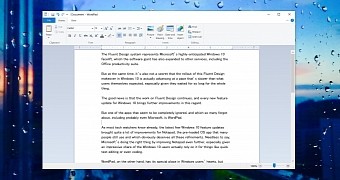The Fluent Design system represents Microsoft’s highly-anticipated Windows 10 facelift, which the software giant has also expanded to other services, including the Office productivity suite.
But at the same time, it’s also not a secret that the rollout of this Fluent Design makeover in Windows 10 is actually advancing at a pace that’s slower than what users themselves expected, especially given they waited for so long for the whole thing.
The good news is that the work on Fluent Design continues, and every new feature update for Windows 10 brings further improvements in this regard.
But one of the apps that seem to be completely ignored, and which so many forgot about, including probably even Microsoft, is WordPad.
As most tech watchers know already, the latest few Windows 10 feature updates brought quite a lot of improvements for Notepad, the pre-loaded OS app that many people still use and which obviously deserves all these refinements. Needless to say, Microsoft’s doing the right thing by improving Notepad even further, especially given an impressive share of the Windows 10 users actually rely on it for things like quick text editing or even coding. WordPad, on the other hand, has its special place in Windows users’ hearts, but Microsoft has more or less ignored it in the most recent Windows 10 feature updates.
In addition to new features, which would technically bring WordPad in line with the rest of the apps on Windows 10, the Fluent Design treatment is also needed, as the current interface more or less reminds of the classic Windows experience rather than the modern approach that Microsoft is pushing hard for.
A WordPad concept that I recently wrote about imagines this highly-anticipated Fluent Design makeover in the app, and while Microsoft may not agree with everything envisioned here, some of the ideas certainly fit WordPad like a glove.
Some users believe that WordPad is more or less a redundant app, especially because Microsoft’s also offering Notepad in Windows 10. And given Notepad has received so much love lately, the software giant should just give up on WordPad and focus on better things going forward, these users say.
But giving up on WordPad isn’t by any means a decision that Microsoft should make right now, and in fact, the company should make sure that all apps in Windows 10 boast the modern experience that it’s betting so big on. In fact, completing the Fluent Design makeover and finalizing the Windows 10 facelift should be a priority for the software giant anyway, especially because the whole thing started several years ago.
The next feature update for Windows 10 is the May 2020 Update, also known as version 2004, and unsurprisingly, it doesn’t bring anything notable on the WordPad front. This isn’t necessarily surprising, as Microsoft has focused on other things, but on the other hand, it could be a little bit of a letdown for others who expected to see WordPad finally getting some love.
Version 2004 is a feature-package release which comes just at the right time. The previous update, called November 2019 Update, was entirely focused on fixing things and refining the performance under the hood, with many describing it as a service pack. Rumor has it that the same approach would be used for the fall 2020 update, which means that any significant improvements for WordPad would just have to wait at least a year to go live on production builds.
For the time being, however, our only option is to see the glass half full: WordPad still offers the same experience that everyone is familiar with.

 14 DAY TRIAL //
14 DAY TRIAL //